
The House of Bourbon is a European dynasty of French origin, a branch of the Capetian dynasty, the royal House of France. Bourbon kings first ruled France and Navarre in the 16th century. By the 18th century, members of the Spanish Bourbon dynasty held thrones in Spain, Naples, Sicily, and Parma. Spain and Luxembourg have monarchs of the House of Bourbon. The royal Bourbons originated in 1272, when Robert, the youngest son of King Louis IX of France, married the heiress of the lordship of Bourbon. The house continued for three centuries as a cadet branch, serving as nobles under the direct Capetian and Valois kings.

Louis XVIII, known as the Desired, was King of France from 1814 to 1824, except for a brief interruption during the Hundred Days in 1815. He spent twenty-three years in exile: during the French Revolution and the First French Empire (1804–1814), and during the Hundred Days.
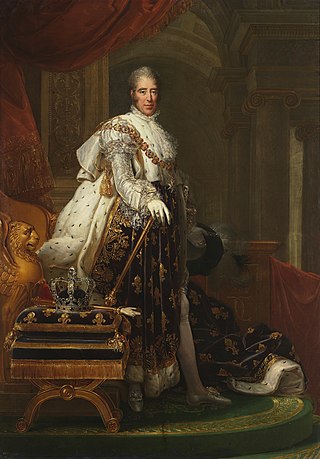
Charles X was King of France from 16 September 1824 until 2 August 1830. An uncle of the uncrowned Louis XVII and younger brother to reigning kings Louis XVI and Louis XVIII, he supported the latter in exile. After the Bourbon Restoration in 1814, Charles became the leader of the ultra-royalists, a radical monarchist faction within the French court that affirmed rule by divine right and opposed the concessions towards liberals and guarantees of civil liberties granted by the Charter of 1814. Charles gained influence within the French court after the assassination of his son Charles Ferdinand, Duke of Berry, in 1820 and succeeded his brother Louis XVIII in 1824.

A chocolate bar or candy bar is a confection containing chocolate, which may also contain layerings or mixtures that include nuts, fruit, caramel, nougat, and wafers. A flat, easily breakable, chocolate bar is also called a tablet. In some varieties of English and food labeling standards, the term chocolate bar is reserved for bars of solid chocolate, with candy bar used for products with additional ingredients.
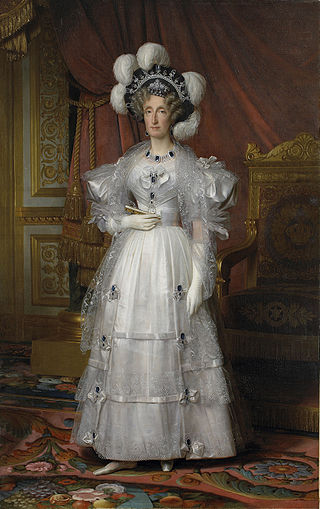
Maria Amalia Teresa of Naples and Sicily was Queen of the French by marriage to Louis Philippe I, King of the French. She was the last queen of France.

Louis Joseph de Bourbon was Prince of Condé from 1740 to his death. A member of the House of Bourbon, he held the prestigious rank of Prince du Sang.

Charles Ferdinand d'Artois, Duke of Berry was the third child and younger son of Charles X, King of France, by his wife Maria Theresa of Savoy. In 1820 he was assassinated at the Paris Opera by Louis Pierre Louvel, a Bonapartist. In June 1832, two years after the overthrow of Charles X, an unsuccessful royalist insurrection in the Vendée was led by Marie-Caroline de Bourbon-Sicile, widow of Charles Ferdinand, in an attempt to restore their son Henri, Comte de Chambord to the French throne.

A bonbon is a small chocolate confection. They are usually filled with liqueur or other sweet alcoholic ingredients, and sold wrapped in coloured foil.

François-Louis Cailler was a Swiss entrepreneur and early chocolatier who founded Cailler, the first modern brand of Swiss chocolate and the oldest still in existence, in 1819.

Swiss chocolate is chocolate produced in Switzerland. While cacao beans and other ingredients such as sugar cane originate from outside Switzerland, the actual production of the chocolate must take place in Switzerland. Switzerland's chocolates have earned an international reputation for high quality with many famous international chocolate brands.

Cailler is a Swiss chocolate brand and production factory based in Broc. It was founded in Vevey by François-Louis Cailler in 1819 and remained independent until the early 20th century, when it associated with other producers. Shortly before, Cailler opened its main factory at Broc in 1898. The company was finally bought by Nestlé in 1929 and became a brand. Cailler is the oldest chocolate brand still in existence in Switzerland.
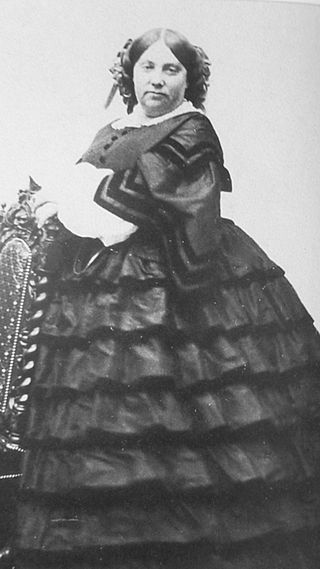
Louise Marie Thérèse d'Artois was a duchess and later a regent of Parma. She was the eldest daughter of Charles Ferdinand, Duke of Berry, younger son of King Charles X of France and Princess Caroline of Naples and Sicily. She served as regent of Parma during the minority of her son from 1854 until 1859.

Maria Clementina of Austria was an Austrian archduchess and the tenth child and third daughter of Leopold II, Holy Roman Emperor and Maria Luisa of Spain. In 1797 she married her double first cousin Prince Francis, Duke of Calabria, heir to the kingdoms of Naples and Sicily. She was modest, well educated and kind, becoming popular in her adoptive country. Afflicted with frail health, she died of tuberculosis, age twenty four. Her only surviving child was Princess Caroline, Duchess of Berry.

Maria Antonia Ferdinanda of Spain was Queen of Sardinia by marriage to Victor Amadeus III of Sardinia. She was the youngest daughter of Philip V of Spain and Elisabeth Farnese. She was the mother of the last three mainline Kings of Sardinia.

Prince Charles of Luxembourg, Prince of Bourbon-Parma and Nassau, was a younger son of Grand Duchess Charlotte and Prince Felix of Bourbon-Parma.

Debauve & Gallais is a French chocolate manufacturer founded by Sulpice Debauve in 1800. After his nephew Antoine Gallais joined the company in 1823, the company adopted their current name. In 1819 the company received the royal warrant as purveyors to the French court, and was the official chocolate supplier for Emperor Napoleon and of kings Louis XVIII, Charles X and Louis Philippe.
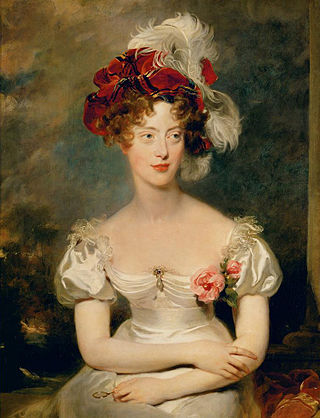
Marie-Caroline of Bourbon-Two Sicilies, Duchess of Berry was an Italian princess of the House of Bourbon who married into the French royal family, and was the mother of Henri, Count of Chambord.

A candy bar is a type of candy that is in the shape of a bar. The most common type of candy bar is the chocolate bar, including both bars made of solid chocolate and combination candy bars, which are candy bars that combine chocolate with other ingredients, such as nuts, caramel, nougat, or wafers.

Princess Marie-Françoise Antoinette Jeanne Madeleine of Bourbon-Parma, known upon her marriage as Princess Edouard de Lobkowicz is a French humanitarian and philanthropist. A princess of the House of Bourbon-Parma by birth and the House of Lobkowicz by marriage, her wedding in 1960 was the first Bourbon wedding to take place at Notre-Dame de Paris since the wedding of Charles Ferdinand, Duke of Berry to Princess Caroline of Naples and Sicily in 1816 during the Bourbon Restoration.
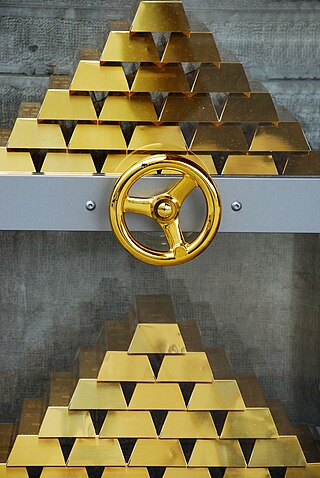
Goldkenn is an industrial Swiss chocolate producer based in Le Locle. It was founded in Geneva in 1980, by Steven Goldstein and Christian Belce-Kennedy, the company name being the combination of the two surnames. The company started selling old-looking wooden chocolate boxes in duty-free stores, in collaboration with Favarger.




















